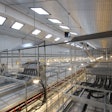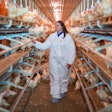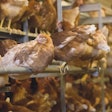
There are five freedoms that animal welfare advocates say need to be provided to animals; freedom from hunger and thirst; from discomfort; from pain, injury or disease; from fear and distress; and to express normal behaviors. When housing laying hens cage-free, it is the freedom to express normal behaviors that leads to the most problems.
One of the problem behaviors that cage-free hens have the freedom to exhibit is to defecate wherever and whenever they want. This “sixth” freedom can create food safety issues, bird health issues, and increase ammonia emissions from the layer house.
On the subject of cage-free housing and food safety, John Sheehan, director, division of dairy, egg and meat safety, CFSAN, FDA, said that, as the industry increases cage-free production in response to customer purchase pledges, “We (FDA) expect to find more contaminated eggs.”
When fielding questions from the audience at the recent United Egg Producer’s Legislative Board Meeting in Washington, D.C., Sheehan said FDA was not consulted on the proposed rule for organic eggs and the requirement that outdoor access for the organic hens be on the dirt without a roof overhead. So the U.S. egg industry appears headed down two paths: more cage-free non-organic hens and organic hens on the dirt outdoors. Both have the potential to jeopardize progress on reducing human illnesses due to egg-borne pathogens.
U.S. egg producers have done a remarkable job reducing the incidence of Salmonella enteritidis (SE) found in environmental samples in layer houses over the past five years. With the number of cage-free hens in the U.S. expected to increase dramatically in the coming years, SE prevention programs will be put to an even tougher test as hens and some eggs come in direct contact with the by-product of the sixth freedom.


















